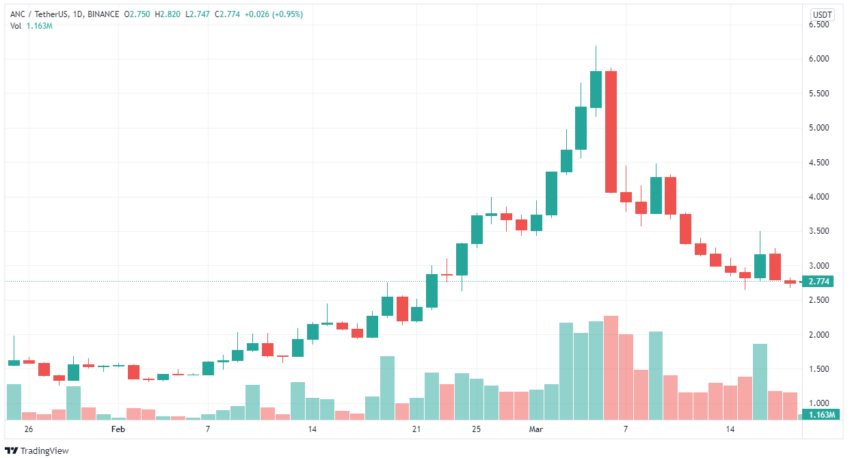The days of earning large DeFi yields from staking or lending your cryptocurrency coins are being challenged by the ever-changing form of the crypto space. Still, there are projects, such as Anchor Protocol, looking to maintain the profits that crypto users have become accustomed to.
In the following guide, we’ll look at how the Anchor Protocol works, its advantages and disadvantages, and try to help you understand if this is worth your time and attention.
In this guide:
- A brief intro on the stablecoin market
- What are stablecoins?
- Anchor Protocol origins
- What is Anchor Protocol?
- What is Earn? How does it work?
- What is Borrow? How does it work?
- How does Anchor Protocol work?
- Benefits of Anchor Protocol
- Security involved
- How to use Anchor Protocol?
- What is the ANC token?
- Tokenomics
- Price and price predictions
- Should you buy ANC?
- How to buy ANC?
- Should you use the Anchor Protocol?
- Anchor Protocol could bring a revolution to savings
- Frequently asked questions
A brief intro on the stablecoin market

Tether is the most popular stablecoin at the moment. However, developers behind the coin have struggled to provide documentation proving the coin’s capability of remaining pegged to the U.S. dollar.
Stablecoins are a group of cryptocurrencies that aim to provide price stability. A reserve asset backs these coins. They are particularly championed by crypto investors looking for an alternative to fiat currencies such as the dollar, the euro, or the rupee.
Stablecoins allow bitcoin investors to quickly convert their profits into a dollar-like amount. They can then invest the amount elsewhere or withdraw the money to their bank accounts. Stablecoins are cryptocurrencies that attempt to link their market value to some kind of external reference.
These coins, primarily, enable investors to instantly “cash-out.” This leaves them without worries about how their crypto portfolios may have changed overnight. It’s a way to avoid some of the instability of the crypto markets.
Stablecoins are unchanging because of a collateralization system or an algorithmic mechanism that allows for the buying and selling of the reference asset or its derivatives.
What are stablecoins?
Stablecoins have the advantage of being able to withstand the volatility of the cryptocurrency markets. They also offer great accessibility and mobility. This makes them, essentially stable, decentralized digital currencies.
UST is the largest decentralized stablecoin, at the moment, when judged by market capitalization. After dethroning DAI, an Ethereum-based competitor, UST reached this milestone. According to available information, the market capitalization of UST stablecoin was approximately $200 million as of 2021.
The stablecoin market is one of the fastest-growing sectors of the crypto industry this year. In 2021, there was a 500% increase in market capital for the largest stablecoin issuers over the previous year.
This increase, however, has also come with growing demands for further regularization. It’s important that companies who issue these types of coins make assurances about their capability to continue to maintain price stability.
Anchor Protocol origins
Anchor Protocol was founded in 2020 and is headquartered in Seoul, South Korea. It was officially launched on Mar. 17, 2021. Terraform Labs (TFL) is the company that developed the application. It was designed to work in conjunction with the blockchain and its cryptocurrency, LUNA.
It was TFL’s vision to integrate three primary financial primitives on the Terra blockchain-based Cosmos SDK, including savings via Anchor and payments via UST.
TFL’s plan was to integrate three main directives. This concerned payments being made using UST, savings using Anchor, and investing with the Mirror Protocol. These are all done on the Cosmos SDK-based Terra blockchain.
Due to the volatility in crypto assets’ prices, staking doesn’t seem a suitable option for most people. Anchor is a savings platform. It pays a dividend based on block rewards from important PoS blockchains. Anchor assigns block rewards to assets that are used to borrow stablecoins in order to provide a consistent yield.
Anchor Protocol was established to increase demand. It offers approximately a 20% yield for lenders.
Anchor is paired with Mirror Protocol and TFL’s Chai wallets to expand the range of use cases for Terra-based stablecoins. The protocol’s ultimate goal is to become an interchain protocol that allows its users to access DeFi services in the Terra-Luna ecosystem.
What is Anchor Protocol?
Anchor Protocol is a Terra-based lending and borrowing protocol. It provides UST depositors a 20% annual percentage return. This is known as APY. Borrowers can use bonded LUNA (bLuna) or bonded ETH (bETH) to secure UST loans.
It uses an over-collateralized architecture to allow users to borrow, lend, and earn interest with their digital assets. The protocol also allows for fast withdrawals and pays depositors a low-volatility rate. It is one of the most well-known stablecoins.
The decentralized savings system offers low-volatile returns on Terra stablecoin deposits. Anchor rates are powered by a diverse stream of staking rewards, from major PoS blockchains. With this in mind, they can be expected to be more stable than money markets interest rates.
Anyone can participate in the protocol. Anchor is a promising savings tool. It is also a decentralized protocol. This means that anyone can join it without KYC from anywhere.
What is Earn? How does it work?
The Anchor Protocol is thought of as a genuine savings option for regular households. The idea would be for users to choose the “Earn” option and then collect the interest without further effort. Because of this, the “Earn” option is the central pillar of the project.
Earn allows users to earn Anchor yields on Terra stablecoins. You can deposit and withdraw Terra stablecoins from it, and track your current deposit value, transactions history, current deposit annualized rate (APY), as well as the amount of Anchor interest earned.
The process is simple. Just visit the Anchor Protocol page. Visit the “Earn” section. Once here click on “Deposit” and enter the required crypto details for the deposit.
If you do now own any UST, you can purchase luna or UST from an exchange that features these assets.
After purchasing it, you will need to withdraw the sum to your Terra Station wallet. Make sure you write down your password and mnemonic phrase.
You also have the option of using the Terra Wallet to swap from luna to the stablecoin UST, and vice versa.
Once you have staked your stablecoin, the interest will be paid to you in an aUST token, which you can convert into UST later. You can then withdraw it whenever you wish, without any inconveniences.
Users can now deposit stablecoins that are based on Ethereum as well. These include BUSD, USDC, DAI, and USDT. The yields are provided in reference to the Anchor Rate.
What is Borrow? How does it work?
The Anchor Protocol also includes the “Borrow” option. This allows users to apply for loans. To do this, the users need to initially generate bAssets (bLuna or bETH). They can do this by visiting the “bAssets” tab.
Terra’s money market is a WebAssembly smart contract. It functions on the Terra blockchain. Terra stablecoins are borrowed and deposited.
Terra money market allows anyone to obtain a loan. However, they must have the appropriate amount of collateral in order to be eligible for the loan. Anchor Protocol maintains an algorithm that determines the interest rates for both the borrower and depositor. This algorithm generates interest rates for loans based on current availability and borrowing demand.
In order to lend Terra stablecoins on the Anchor’s market, incentives are provided. Borrowers receive the Terra stablecoins through a bAsset collateralized loan. They provide interest to depositors. Furthermore, deposited collaterals generate subsidies.
The “Borrow” element of the Anchor Protocol potentially offers large rewards for users. At a nominal rate, users can borrow stablecoins (UST), against their collateral (LUNA/ETH).
When you want to withdraw your funds, you will need to hit the “Repay” button. This allows you to withdraw the collateral that you have provided. You will then visit the “Bond” tab and “Burn” that collateral.
The platform will provide you with two options on the “Burn” tab. With “Direct Burn,” as the name implies, you will have to wait for 24 days to receive your Luna collateral back. The wait time is due to the coin being part of Terra’s staking system.
You also have the option for “Immediate Burn.” With this, you receive an instant withdrawal. However, you will need to pay larger fees overall.
How does Anchor Protocol work?
In essence, the Anchor Protocol is meant to be a decentralized application that caters to people who want to borrow crypto and receive a stable yield on their deposits.
The Anchor Protocol looks to create a balance between the two categories through a permissionless and decentralized application. Understanding how Anchor Protocol works will help us better understand the DeFi landscape. Let’s take a brief look at how Anchor Protocol functions.
As previously mentioned, Anchor Protocol follows three main objectives.
- The first concerns payments in UST.
- The second refers to savings made using Anchor.
- Thirdly, it’s an investment opportunity. It does these things using loan liquidation, the bonded assets (bAsset) that we mentioned, and the platform’s money market.
A bAsset can be described as a tokenized stake on a PoS blockchain. Technically, bAssets can be created on any PoS blockchain that supports smart contracts. This token, just like the asset you staked, will grant you block rewards.
A bAsset is different from a staked asset in that it is fungible and can be transported. This means that transactions are with the bAsset just like you would with the underlying asset.
Utilizing the Terra blockchain

A Web Assembly smart contract governs the money market on the Terra blockchain. This governs the borrowing and lending system, with the UST stablecoin at its core. Essentially, when you deposit coins on Terra, you are contributing to a pool. The loan interests derive from this pool.
Borrowing coins involves providing some coins back as collateral. The exact amount is calculated based on supply and demand within the protocol. Similarly, interest rates are paid out based on an algorithm maintained on the Anchor Protocol. The algorithm considers the same supply and demand factors. This is the Anchor Rate. In order to determine the rate, the smart contract will split the block rewards obtained from the bAssets acting as collateral between the depositors and the borrowers.
As we mentioned earlier, Anchor Protocol aims at providing yields of up to 20%. The UST stablecoin provides the yields. bETH and bLuna are the recognized bAssets.
Benefits of Anchor Protocol
Anchor Protocol looks to distinguish itself from potential market rivals through a few essential features. First of all, it provides a high yield in exchange for deposits. Furthermore, it allows for instant withdrawals of funds. Lastly, the interest rate involves low volatility. All of this makes it a potentially good savings opportunity.
Users who have acquired bAssets can earn a steady yield through staking. This incentivizes the use of the protocol. Because it accepts bAssets as collateral, the Anchor Protocol has the qualities to become a long-term proposition.
Generally speaking, crypto assets are not the best choice for customers who are searching for low-risk passive income. Anchor looks to solve this. Depositors of Terra stablecoin will be able to receive stablecoins in return. In this way, the volatility associated with crypto assets is avoided.
Users can borrow stablecoins with their assets. They can also then buy more of the same asset to increase their leverage. Users can also benefit from low rates by borrowing stablecoins at a lower cost and investing in bAssets with a higher yield than the borrowing cost.
Security involved
We’ve looked at the opportunities presented by Anchor Protocol. To fully understand the security presented here, it is important to also look at the risks involved. In this case, they refer to two types. The first is the smart contract risk. The second is the risk associated with the UST pegging status.
Smart contracts are an incredible use of modern technology. Still, they are also susceptible to cyberattacks and technology failures. Like any other software code, smart contracts require rigorous testing and appropriate controls to minimize potential risks to blockchain-based business processes.
Hackers may be able to steal money from users if there is a security hole in the blockchain network that hosts a smart contract. The fraudulent activity might not be detected. Hackers can exploit this.
Terra has, however, partnered with various third-party insurance providers to offer plans that reduce the risk of smart contracts and de-pegging. Furthermore, Terra has contracted two audit firms to ensure that the protocol is safe for all its users. They conduct regular audits to identify any potential security issues.
Stablecoin stability
Another risk is the one regarding the consistent value of the stablecoin. An algorithm calculates the value of UST. The cryptocurrency LUNA backs its value.
It is possible that the conversion ratio to the stablecoin can differ when the markets for LUNA are particularly volatile. To bring UST back to $1, the protocol must burn LUNA. This will mean that less LUNA is available to sell.
UST has remained fairly stable. However, it has only been around since the late 2020s. Market volatility conditions require further tests. For example, IRON, a USD-pegged coin, saw its value plummet in 2021. This happened despite USDC backing. However, throughout Terra’s ecosystem, you can find UST. Pylon, Anchor, and Mirror protocols are part of it.
How to use Anchor Protocol?
Anchor Protocol is a decentralized savings protocol that allows users to benefit in a number of ways. Let’s learn how to start using it.
The Anchor Protocol uses a number of wallets. However, the easiest method involves using the Terra Station browser wallet. This connects them to applications on the Terra blockchain.
Install your wallet first, then access the Anchor Protocol and choose the “Connect Wallet” option. You will need to scan the QR code and link up your wallet.
Next, you will need to confirm the interaction and connect to the Anchor Protocol DApp. As mentioned previously when setting up your wallet, make sure to properly write down your seed phrase, as well as your password. Your security information allows you to access the wallet from any browser, on any device.
What is the ANC token?
Anchor Protocol’s governance token is the Anchor Token (ANC). The deposited tokens create governance polls. Those who have staked ANC vote on these.
You can buy or sell ANC tokens to become involved in the governance process. The tokens improve reward conditions as well. Finally, ANC–UST pool includes the staked tokens.
Tokenomics
The total supply of ANC tokens is 1 billion. The current circulating supply is at around 264 .6 million ANC. Incentives for Anchor Protocol borrowers for the next four years involve 40% of the reserved amount.
Price and price predictions

As with purchasing any other cryptocurrency, it is important to consider a number of factors. One of these is the volatility of the market. This is inherent to the crypto environment. Any forecast must take this into account. Naturally, the thought process of the coin’s success should also include the success of the project.
The current price for Anchor Protocol is around $2.83. ANC’s current circulation supply is 264.6 million, and its market cap is $747.8 million. The Anchor Protocol’s price rose by almost 5% over recent days. This was due to an increase in trading volume and market capital.
ANC, like other coins, has faced some setbacks in recent times. Over the past week, the token’s price has fallen by nearly 31.14%. This has made some analysts doubt the short-term investment potential of ANC. However, the sound project behind it gives long-term investors hope.
Some crypto analysts predict a price increase to $3.70 by the end of 2022. The same analysts think that ANC could hit an all-time high of $6.10 by the end of 2023, and could reach almost $10 by 2025.
Should you buy ANC?
According to most crypto analysts, recent statistical data does not seem to suggest that ANC is a great short-term investment. However, the same analysts are optimistic about the token’s mid and long-term prospects. They believe that in five years’ time, ANC could reach $16. The same analysts also bank on a consistent rise in the pricing of the token over the following years.
How to buy ANC?
The Anchor Protocol native token is available on several high-profile exchanges. These include Binance and KuCoin. The process of purchasing ANC is identical to buying other crypto listed on those exchanges. Buyers will need to:
- Study the ANC pricing on the various exchanges. They will need to decide on the exchange that best suits their needs.
- Next, they will need to create an account with any of those exchange services.
- They then need to deposit funds into their account.
- Finally, they can purchase ANC at the price available on the exchange. They can hold the Anchor Protocol token inside the exchange, in their crypto wallet, or move it to the Anchor Platform itself.
Should you use the Anchor Protocol?
When investing in any kind of crypto-related project, it is important to see both the short-term and long-term goals of your investment. Currently, Anchor Protocol offers a high yearly yield of nearly 20%. It also promises little risk and protection against market volatility through its stablecoin.
The platform itself is easy to use. Novices can easily approach the process of purchasing native coins and staking them. Furthermore, while the investment is not risk-free, the project has attracted good reviews thus far. Using the Anchor Protocol is a good way to earn passive income and embrace the Terra ecosystem.
Anchor Protocol could bring a revolution to savings
Just about everyone involved in the cryptocurrency world is looking for ways to earn extra income and diversify their portfolio. The Anchor Protocol is a good way to do both.
Anchor Protocol presents itself as a genuine savings solution for those within the Terra ecosystem. There is a risk with this. It involves the value of the staked stablecoin. It could also be vulnerable to smart contract risks. However, third-party actors monitor the situation according to the Anchor Protocol.
Overall, the Anchor Protocol seems to be a good investment strategy for crypto users and an exciting demonstration of the possibilities offered by the Terra blockchain.
Frequently asked questions
What is Anchor Protocol?
How do I get Anchor Protocol (ANC)?
How does the Anchor Protocol give you interest?
How do I deposit in Anchor protocol?
Trusted
Disclaimer
In line with the Trust Project guidelines, the educational content on this website is offered in good faith and for general information purposes only. BeInCrypto prioritizes providing high-quality information, taking the time to research and create informative content for readers. While partners may reward the company with commissions for placements in articles, these commissions do not influence the unbiased, honest, and helpful content creation process. Any action taken by the reader based on this information is strictly at their own risk. Please note that our Terms and Conditions, Privacy Policy, and Disclaimers have been updated.




